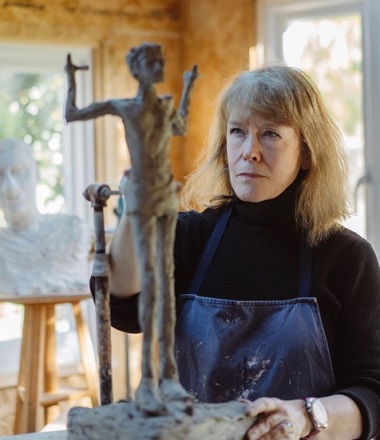
Colleen McLaughlin Barlow working on ‘Jesus Takes up the Cross.’
Three local artists are part of a unique artistic expression of the gospel in Toronto.
Crossings: A Journey to Easter (March 2 – April 14) is:
. . . an all-outdoor art exhibition featuring 16 art pieces depicting the scriptural stations of the cross. Set at sites throughout downtown and midtown Toronto, Crossings draws upon the centuries-old Christian spiritual practice of walking and praying the path that Jesus took on his way to the cross.
In this exhibit, the Stations are captured through sacred art pieces expressing the dramatic moments of Jesus’ final hours.
This pilgrimage-style Journey to Easter will take visitors figuratively along the journey that Jesus took through unjust suffering leading to redemption. It [provides] an opportunity to reflect on what the Jesus story offers as a way to respond to the contemporary social justice issues of today.
Colleen McLaughlin Barlow created ‘Jesus Takes Up the Cross’ for Crossings. She emailed me about the initiative:
This is truly a different way to reach people with the gospel. Local churches are doing the pilgrimage route through the stations and thousands of people on their way to and from work are looking at the work.
I personally saw several people over the course of the media interviews in front of my piece, misting up . . . actually crying while looking at the figure?! . . .
All the artists got to meet up at a sort of Mardi Gras night before Ash Wednesday’s opening and it was so interesting to talk to other artists, who, like myself have never done an overtly religious piece of art before. We all shared the specific difficulties and challenges of engaging with the narrative of the passion of the Christ – it was sort of a spiritual exercise and we had to pray our way through doing it!
Raised in Metro Vancouver and a long-time member of St. John’s Vancouver Church, Colleen has recently moved to Cambridge, England with her husband Martin (who was educated there and recently retired as a math professor at UBC).
Betty Spackman (Station 3: ‘Jesus is Condemned by the Sanhedrin’) and Patricia June Vickers (Station 2: ‘Jesus is Betrayed by Judas and Arrested’) are also based in the Vancouver area.
Stations of the Cross
 Crossings Toronto is part of the Stations of the Cross public art project, which began in London in 2016, and has since traveled to Washington, DC (2017), New York City (2018), Amsterdam (2019), and Deventer in the Netherlands (2020).
Crossings Toronto is part of the Stations of the Cross public art project, which began in London in 2016, and has since traveled to Washington, DC (2017), New York City (2018), Amsterdam (2019), and Deventer in the Netherlands (2020).
(Metro Vancouver visual artist Erica Grimm took part in the Amsterdam exhibition.)
Following a COVID-19 hiatus, Stations of the Cross has come to Canada. Though Crossings has a history, each iteration is unique.
John Franklin, founder of Imago Arts, which sponsored the exhibition, told me, “Crossings is distinctly Toronto.”
Speaking with Colleen, he said (at 9:22 of video):
This is not just a religious story – it is that, of course – it’s a deeply human story. It’s about betrayal, it’s about unjust judgment and it’s about suffering; you could go on down the list.
So we want these stations also, not just to speak of the story of Jesus, but to open up our own hearts and minds to see the relevance of this story for social concerns in the culture. It’s got so much to say to so much that is going on today.
At each station there is a scripture reading and a poetry reflection to accompany the visual art. At least one of the poets (Violet Nesdolay) is from Vancouver.
Imago
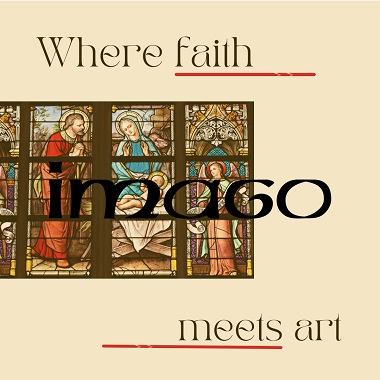 John Franklin, who lives in Toronto, has been tireless in working with artists over the years.
John Franklin, who lives in Toronto, has been tireless in working with artists over the years.
He explains Imago’s vision:
In addition to the projects we oversee, Imago is committed to promote unique artistic events, partner with others to sponsor lectures by outstanding artists and scholars and bring together artists and audiences, highlighting the work of emerging and established Canadian artists. . . .
Art serves as a humanizing presence, a role that has been under-appreciated in our culture. Given the current state of affairs in our global community it should be evident that the presence of art is critical as a resource for bridging our differences and offering some threads of hope in the deeply troubling situations we face.
An ambivalence concerning the arts remains as we live in a society where technology and the pressures of a consumerist agenda shape our thinking, devour our time and often leave us less imaginative than we might otherwise be.
The arts bring not only delight but also a thread of hope and a glimpse into what might be. These qualities are consistent with the Judeo-Christian values which ground the work of Imago. Central to all that Imago does is the practice of hospitality.
Colleen McLaughlin Barlow

Click on this image to view a 10 minute video in which Colleen (and others) describe the process of creating ‘Jesus Takes Up the Cross.’
Colleen McLaughlin Barlow has incorporated a lifetime of experience and observation into ‘Jesus Takes Up the Cross.’
The bronze figure of Christ is holding a silver cross which is itself encapsulated in a human sacrum made from acrylic.
The sacrum, she points out, “is the centre bone of the pelvis, the tailbone at the back. It is the centre of the human skeleton and in this sculpture, is representative of all humanity (‘cause everyone has a sacrum).”
Colleen’s introduction to her work on the Crossing site gives a sense of how these elements tie together:
Cancer led me to a dissecting room. I saw the component parts of us: you, me, humanity. Moved by the beauty of these structures, I began to draw, paint and sculpt landscapes of mortality.
Upon hearing the diagnosis ‘cancer’ I was numb with shock. Everything about my life was to change. The gift of the disease was an acute awareness of my own mortality. I went to Florence to study art and a chance tour brought me to an astonishing place: La Specola.
It is an 18th century facility for the instruction of art and medical students. The models are life-sized and created of wax and represent every aspect of the dissected human body. There are hearts and livers, spleens and uteri, skeletons and nerves, sinews and joints – all extremely realistic.
I stood in the middle of the room and wept at the ‘terrible beauty.’ These were extraordinary landscapes which house the soul – structures formed by expediency and evolution. My mind was on fire with the intelligence of what I saw.
That initial exposure to the human body at La Specola in Florence led to a decade of odyssey from Italy to Vancouver, Toronto, Cambridge, Oxford, the Scottish Hebrides, Vienna, the Atacama desert in Chile and the Vatican. Courteous sponsorship enabled me to work in human and animal anatomy laboratories as well as telescope observatories around the world.
I have enlarged my practice to include animal as well as human bones and other structures from nature.
My art is featured in a number of private collections in the UK, Canada, the USA, Ireland and Japan. My work is also in the National Collection of Ireland, the Department of Animal Anatomy at Cambridge University, the New Hall Art Collection at Murray Edwards College at Cambridge University and the Vatican.

Station 8: ‘Jesus Takes Up the Cross,’ in front of St. Basil’s Catholic Church.
Colleen emailed this response to my wife Margaret, when she asked about the significance of the sacrum:
Years ago when I was making all those sculptures of human bones, I studied the sacra of so many dead people over at the UBC Anatomy Dept. – old men, young women, different ethnicities, even babies, and made clay ‘portraits’ of each bone and then cast them into lead crystal.
I worked very faithfully and tried to make the sculptures very true to life. There was always an illuminated cross or even a cruciform figure. I remember thinking that I wanted to use that knowledge someday – that at our very centre, there is a cross of light.
It is very hard to photograph it but there is not only a metal cross in the centre of my sculpture, but a cross of light coming through it. The silver wire cross I made to go into the centre is illuminated by the surface contours of the sacrum which make it into a big lens.
I really feel that this project has been led by God for quite a long time now – even to the point of having a fellow Christian in my Bible study in Canada who was a filmmaker who wanted to make a documentary about the commission.
I have been blessed by finding two different foundries (for the cross/sacrum and the figure) who were fantastic and who could schedule the work into a crazy busy, Covid-limited time and also, daily, praying that my hands would do God’s will on this assignment.
It has been the most challenging and difficult piece of art I have ever worked on. I was extremely nervous about how it would be perceived.
At both foundries, people told me stories about it. Several guys who worked on it told me specific instances that they felt moved to pray again – one guy is going back to church. A woman told me that she didn’t want it to leave the foundry because for several weeks she used to just look at it and think about Jesus – a little contemplation.
These are people at busy foundries who see thousands of gorgeous sculptures moving through their lives all the time. Isn’t that amazing?! I was very humbled by it. About 30 people over here have now seen it and Tze, the videographer who filmed the molten metal at the foundry etc. told me he was having dreams about it – by what he sees in the face – kindness and hope and love.
So I’m glad you wondered what that bone was, Margaret! That is rather the point of the whole piece from my perspective.
Many, many artists have produced a tired, beat up guy lugging lumber up a hill for this commission. My vision was different – it is about the essential beauty of the moment that he decides to do what he is going to do and in that decision, he lifts us up – all of humanity.
Go here for links to three YouTube videos, including one about Colleen’s inspiration for the commission.
Betty Spackman
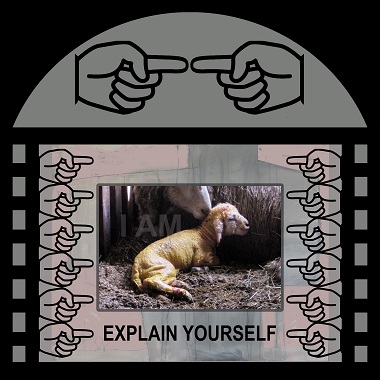 Betty Spackman’s ‘Jesus is Condemned by the Sanhedrin’) is at Station 3. Here is the write-up on the Crossings site:
Betty Spackman’s ‘Jesus is Condemned by the Sanhedrin’) is at Station 3. Here is the write-up on the Crossings site:
Betty Spackman is a multimedia installation artist, painter, educator and author. She has worked, taught and exhibited internationally for over 20 years and spoken at conferences and galleries in Canada, Europe, the U.S. and Mexico. She has a background in theatre, animation, performance art and video art.
Spackman’s work has often centred on cultural objects and the stories connected to them. Her recent focus is on issues of animal/human relations including ‘Found Wanting. A Multimedia Installation Regarding Grief and Gratitude’ (2010-11).
Her current project, ‘A Creature Chronicle. Considering Creation: Faith and Fable. Fact and Fiction.’ continues to address these issues with a focus on questions raised in the theories and practice of Posthumanism, comparing the use of creation narratives in faith, science and art.
She has written and illustrated art-related books including, A Profound Weakness: Christians and Kitsch, a 500-page illustrated book published in 2005 by Piquant Editions, UK which is about images of faith in popular culture.
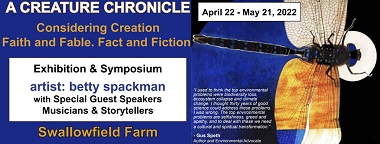 Spackman has taught studio art at several universities in Canada and the US as well as in various community arts programs and developed ‘The Open Studio Program,’ an alternative community education model for emerging artists.
Spackman has taught studio art at several universities in Canada and the US as well as in various community arts programs and developed ‘The Open Studio Program,’ an alternative community education model for emerging artists.
She is co-founder of the Fort Gallery in Fort Langley, BC.
Patricia June Vickers
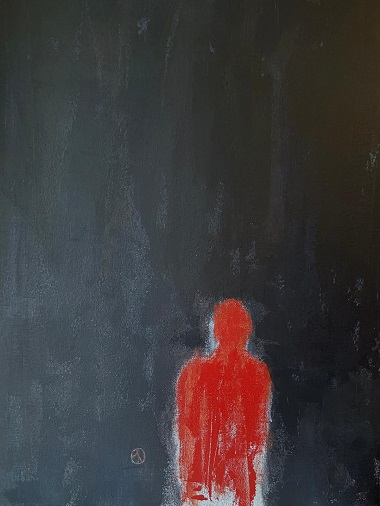 ‘Jesus is Betrayed by Judas and Arrested’ by Patricia June Vickers will be at Station 2. Here is the write-up on the Crossings site:
‘Jesus is Betrayed by Judas and Arrested’ by Patricia June Vickers will be at Station 2. Here is the write-up on the Crossings site:
Patricia June Vickers speaks of her interest in art as coming through a culture that is rich with symbolism, metaphors, grace and beauty.
With roots in the United Kingdom on her mother’s side and Indigenous of the Northwest coast on her father’s side, inspiration was found in everyday life through her paternal grandparents and her older siblings and their cultural and artistic passions.
Patricia chose to study under different artists that inspired her, learning techniques and methods for watercolour, acrylic, oil, encaustic and cold wax.
She works toward interpretation of lived experience through texture, hue, composition expressing the spiritual and supernatural. Her goal with each painting is to create a piece that has healing medicine, and portrays aspects of the actual coupled with mystery.
Go here for an introduction to all the Crossings Toronto artists. Imago has published a Crossings Companion Catalogue.

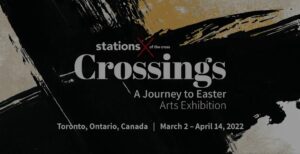
Great article, and great artwork. Almost want to go to Toronto . . .
This is wonderful detailed coverage for the Crossings Toronto exhibition. It is a unique venture that seeks to articulate through the arts the iconic story of the Passion narrative. The art is diverse in style and substantial is taking up the themes found in the biblical texts for the Scriptural Stations of the Cross.
We are pleased to have three west coast artists participating in the project – among the poets there are also some from BC. Grateful for your interest in the project and this good piece to inform your readers.
John Franklin Curator Crossings Toronto, Executive Director IMAGO